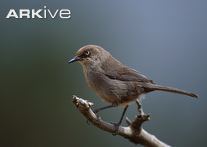Order Passeriformes Genus Sylvia Higher classification Typical warbler | Phylum Chordata Scientific name Sylvia buryi Rank Species | |
 | ||
Similar Layard's warbler, Banded parisoma, Brown parisoma, Arabian warbler, Chestnut‑vented warbler | ||
The Yemen warbler or Yemen parisoma (Sylvia buryi) is a species of Old World warbler in the family Sylviidae. It is found in Saudi Arabia and Yemen where its natural habitat is subtropical or tropical dry forests. It is threatened by habitat loss and the International Union for Conservation of Nature has assessed its conservation status as being "vulnerable".
Contents
Taxonomy
The Yemen warbler was first described in 1913, by the Scottish ornithologist William Robert Ogilvie-Grant, as Parisoma buryi in the babbler family Timaliidae. However examination of its mitochondrial DNA, vocalizations, behaviour and form led to it being transferred to the genus Sylvia in the Sylviidae family. The type locality is Menacha, in Yemen. This warbler is closely related to the brown parisoma (Sylvia lugens).
Description
The Yemen warbler reaches a length of 15 cm (6 in) and has a weight of around 22 g (0.8 oz). The sexes are similar in appearance and have dark brown upper parts and whitish underparts. The beak is slightly curved, the wings are relatively short and the tail rather long.
Behaviour
The Yemen warbler is found in Acacia woodland, hedgerows and bushy areas in mountain regions of southwestern Saudi Arabia and Yemen. Its song is a short, thrush-like warble, often sung from a hidden perch. It feeds largely on insects including caterpillars, but also takes fruit and sips nectar. Breeding takes place between March and July, and the male and female stay together for much of the year.
Status
In Yemen, this warbler is often found in Vachellia origena woodland while in Saudi Arabia it also occurs in woodland dominated by African juniper. It is threatened by a reduction in forest cover as lopping and felling of trees takes place for harvesting fuel and fodder, and little tree regeneration occurs. It is estimated that the total number of individual birds is in the range 3,500 to 15,000, and the International Union for Conservation of Nature has assessed its conservation status as being "vulnerable".
